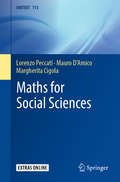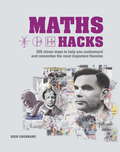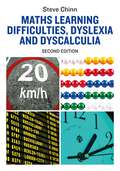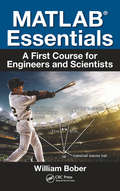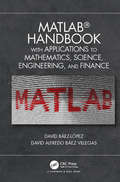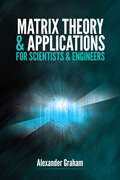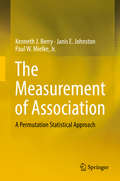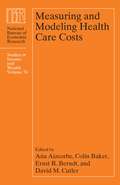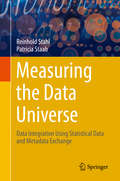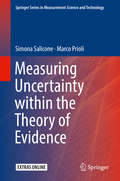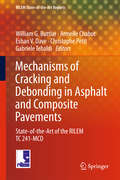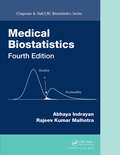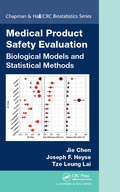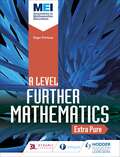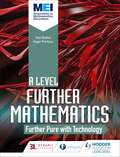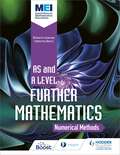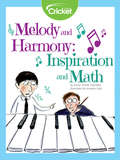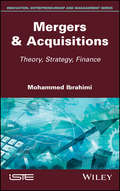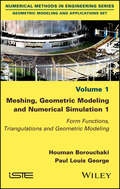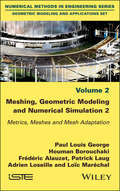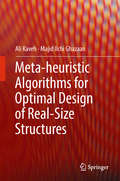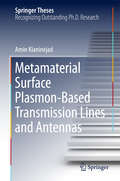- Table View
- List View
Maths for Social Sciences
by Lorenzo Peccati Mauro D’Amico Margherita CigolaThis book is aimed at students in social sciences programs that include some course in quantitative methods. Stats for social sciences is frequently the subject of textbooks, while maths for social sciences is often neglected: monographs on specific themes (like, for instance, social choice systems or game theory applications) are available, but they do not adequately cover the topic in general. This textbook stems from the Bocconi University’s new "Bachelor in Government", which was launched in 2015, and is intended for undergraduate students who do not exclude maths from their toolbox. It discusses various concrete applications in political economics, political science, sociology, and demography and explores topics like Grexit, Macron’s success, immigration effects and the Arab Spring.
Maths Hacks (Hacks)
by Richard CochraneEverything you need to know about 100 key mathematical concepts condensed into easy-to-understand sound bites designed to stick in your memory and give you an instant grasp of the concept.On each topic, you'll start with a helicopter overview of the subject, which will give you an introduction to the idea and some context surrounding it. Next, you'll zoom in on the core elements of the theory, with clear explanation of each point to make sure you really understand the concept, along with simple examples that everyone can follow. Finally, you'll be given a one-liner hack to really make the theory stick in your mind. The perfect introduction to algebra, logic, probability and much more, this is a great new way to learn about the most important mathematical ideas and concepts in a way that makes them easy to recall even months after reading the book.Topics covered include:NumbersAlgebraLogicGeometryProbabilityComputer scienceApplied mathematicsMechanicsStatisticsSet Theory
Maths Hacks
by Richard CochraneEverything you need to know about 100 key mathematical concepts condensed into easy-to-understand sound bites designed to stick in your memory and give you an instant grasp of the concept.On each topic, you'll start with a helicopter overview of the subject, which will give you an introduction to the idea and some context surrounding it. Next, you'll zoom in on the core elements of the theory, with clear explanation of each point to make sure you really understand the concept, along with simple examples that everyone can follow. Finally, you'll be given a one-liner hack to really make the theory stick in your mind. The perfect introduction to algebra, logic, probability and much more, this is a great new way to learn about the most important mathematical ideas and concepts in a way that makes them easy to recall even months after reading the book.Topics covered include:NumbersAlgebraLogicGeometryProbabilityComputer scienceApplied mathematicsMechanicsStatisticsSet Theory
Maths Learning Difficulties, Dyslexia and Dyscalculia: Second Edition (Dyslexia Essentials Ser.)
by Steve ChinnWritten by a world authority on maths difficulties in children, this accessible guide provides tried and tested visual strategies and tailored techniques to help teachers and parents support children with SpLDs who need help with maths.Drawing on the latest research, into areas such as cognition and meta-cognition, along with the authors' decades of teaching experience, the book offers insight into how maths learning difficulties, including dyslexia, dyscalculia and maths anxiety, make maths difficult. Each chapter looks at foundational areas of maths learning that children may struggle with, from early number experiences to basic addition and subtraction, times tables, measurement and more. Essential reading for any teacher, learning assistant or parent supporting children with maths.
MATLAB® Essentials: A First Course for Engineers and Scientists
by William BoberAll disciplines of science and engineering use numerical methods for complex problem analysis, due to the highly mathematical nature of the field. Analytical methods alone are unable to solve many complex problems engineering students and professionals confront. Introduction to MATLAB® Programming for Engineers and Scientists examines the basic elements of code writing, and describes MATLAB® methods for solving common engineering problems and applications across the range of engineering disciplines. The text uses a class-tested learning approach and accessible two-color page design to guide students from basic programming to the skills needed for future coursework and engineering practice.
MATLAB Handbook with Applications to Mathematics, Science, Engineering, and Finance
by Jose Miguel David Baez-Lopez David Alfredo Baez VillegasThe purpose of this handbook is to allow users to learn and master the mathematics software package MATLAB®, as well as to serve as a quick reference to some of the most used instructions in the package. A unique feature of this handbook is that it can be used by the novice and by experienced users alike. For experienced users, it has four chapters with examples and applications in engineering, finance, physics, and optimization. Exercises are included, along with solutions available for the interested reader on the book’s web page. These exercises are a complement for the interested reader who wishes to get a deeper understanding of MATLAB. <P><P>Features <P><P>Covers both MATLAB and introduction to Simulink <P><P>Covers the use of GUIs in MATLAB and Simulink <P><P>Offers downloadable examples and programs from the handbook’s website <P><P>Provides an introduction to object oriented programming using MATLAB <P><P>Includes applications from many areas <P><P>Includes the realization of executable files for MATLAB programs and Simulink models
Matrix Theory and Applications for Scientists and Engineers (Dover Books on Mathematics)
by Alexander GrahamA comprehensive text on matrix theory and its applications, this book is intended for a broad range of students in mathematics, engineering, and other areas of science at the university level. Author Alexander Graham avoids a simple catalogue of techniques by exploring the concepts' underlying principles as well as their numerous applications. Many problems elucidate the text, which includes a substantial answer section at the end. The treatment explores matrices, vector spaces, linear transformations, and the rank and determinant of a matrix. Additional topics include linear equations, eigenvectors and eigenvalues, canonical forms and matrix functions, and inverting a matrix. A Solution to Problems Section, References and a Bibliography conclude the treatment.
The Measurement of Association: A Permutation Statistical Approach
by Kenneth J. Berry Janis E. Johnston Paul W. Mielke<p>This research monograph utilizes exact and Monte Carlo permutation statistical methods to generate probability values and measures of effect size for a variety of measures of association. Association is broadly defined to include measures of correlation for two interval-level variables, measures of association for two nominal-level variables or two ordinal-level variables, and measures of agreement for two nominal-level or two ordinal-level variables. Additionally, measures of association for mixtures of the three levels of measurement are considered: nominal-ordinal, nominal-interval, and ordinal-interval measures. Numerous comparisons of permutation and classical statistical methods are presented. <p>Unlike classical statistical methods, permutation statistical methods do not rely on theoretical distributions, avoid the usual assumptions of normality and homogeneity of variance, and depend only on the data at hand. This book takes a unique approach to explaining statistics by integrating a large variety of statistical methods, and establishing the rigor of a topic that to many may seem to be a nascent field. This topic is relatively new in that it took modern computing power to make permutation methods available to those working in mainstream research. <p>Written for a statistically informed audience, it is particularly useful for teachers of statistics, practicing statisticians, applied statisticians, and quantitative graduate students in fields such as psychology, medical research, epidemiology, public health, and biology. It can also serve as a textbook in graduate courses in subjects like statistics, psychology, and biology.</p>
Measuring and Modeling Health Care Costs (National Bureau of Economic Research Studies in Income and Wealth #76)
by Ana Aizcorbe Colin Baker Ernst R. Berndt David M. CutlerHealth care costs represent a nearly 18% of U.S. gross domestic product and 20% of government spending. While there is detailed information on where these health care dollars are spent, there is much less evidence on how this spending affects health. The research in Measuring and Modeling Health Care Costs seeks to connect our knowledge of expenditures with what we are able to measure of results, probing questions of methodology, changes in the pharmaceutical industry, and the shifting landscape of physician practice. The research in this volume investigates, for example, obesity’s effect on health care spending, the effect of generic pharmaceutical releases on the market, and the disparity between disease-based and population-based spending measures. This vast and varied volume applies a range of economic tools to the analysis of health care and health outcomes. Practical and descriptive, this new volume in the Studies in Income and Wealth series is full of insights relevant to health policy students and specialists alike.
Measuring the Data Universe: Data Integration Using The Statistical Data And Metadata Exchange
by Patricia Staab Reinhold StahlThis richly illustrated book provides an easy-to-read introduction to the challenges of organizing and integrating modern data worlds, explaining the contribution of public statistics and the ISO standard SDMX (Statistical Data and Metadata Exchange). As such, it is a must for data experts as well those aspiring to become one.Today, exponentially growing data worlds are increasingly determining our professional and private lives. The rapid increase in the amount of globally available data, fueled by search engines and social networks but also by new technical possibilities such as Big Data, offers great opportunities. But whatever the undertaking – driving the block chain revolution or making smart phones even smarter – success will be determined by how well it is possible to integrate, i.e. to collect, link and evaluate, the required data. One crucial factor in this is the introduction of a cross-domain order system in combination with a standardization of the data structure. Using everyday examples, the authors show how the concepts of statistics provide the basis for the universal and standardized presentation of any kind of information. They also introduce the international statistics standard SDMX, describing the profound changes it has made possible and the related order system for the international statistics community.
Measuring Uncertainty within the Theory of Evidence: Within The Theory Of Evidence (Springer Series in Measurement Science and Technology)
by Simona Salicone Marco PrioliThis monograph considers the evaluation and expression of measurement uncertainty within the mathematical framework of the Theory of Evidence. With a new perspective on the metrology science, the text paves the way for innovative applications in a wide range of areas. Building on Simona Salicone’s Measurement Uncertainty: An Approach via the Mathematical Theory of Evidence, the material covers further developments of the Random Fuzzy Variable (RFV) approach to uncertainty and provides a more robust mathematical and metrological background to the combination of measurement results that leads to a more effective RFV combination method.While the first part of the book introduces measurement uncertainty, the Theory of Evidence, and fuzzy sets, the following parts bring together these concepts and derive an effective methodology for the evaluation and expression of measurement uncertainty. A supplementary downloadable program allows the readers to interact with the proposed approach by generating and combining RFVs through custom measurement functions. With numerous examples of applications, this book provides a comprehensive treatment of the RFV approach to uncertainty that is suitable for any graduate student or researcher with interests in the measurement field.
Mechanisms of Cracking and Debonding in Asphalt and Composite Pavements: State-of-the-art Of The Rilem Tc 241-mcd (RILEM State-of-the-Art Reports #28)
by Gabriele Tebaldi Christophe Petit Eshan V. Dave Armelle Chabot William G. ButtlarPremature cracking in asphalt pavements and overlays continues to shorten pavement lifecycles and creates significant economic and environmental burden. In response, RILEM Technical Committee TC 241-MCD on Mechanisms of Cracking and Debonding in Asphalt and Composite Pavements has conducted a State-of-the-Art Review (STAR), as detailed in this comprehensive book. Cutting-edge research performed by RILEM members and their international partners is presented, along with summaries of open research questions and recommendations for future research. This book is organized according to the theme areas of TC 241-MCD - i.e., fracture in the asphalt bulk material, interface debonding behaviour, and advanced measurement systems. This STAR is expected to serve as a long term reference for researchers and practitioners, as it contributes to a deeper fundamental understanding of the mechanisms behind cracking and debonding in asphalt concrete and composite pavement systems.
Medical Biostatistics (Chapman & Hall/CRC Biostatistics Series)
by Abhaya Indrayan Rajeev Kumar MalhotraEncyclopedic in breadth, yet practical and concise, Medical Biostatistics, Fourth Edition focuses on the statistical aspects ofmedicine with a medical perspective, showing the utility of biostatistics as a tool to manage many medical uncertainties. This edition includes more topics in order to fill gaps in the previous edition. Various topics have been enlarged and modified as per the new understanding of the subject.
Medical Product Safety Evaluation: Biological Models and Statistical Methods (Chapman & Hall/CRC Biostatistics Series)
by Tze Leung Lai Jie Chen Joseph HeyseMedical Product Safety Evaluation: Biological Models and Statistical Methods presents cutting-edge biological models and statistical methods that are tailored to specific objectives and data types for safety analysis and benefit-risk assessment. Some frequently encountered issues and challenges in the design and analysis of safety studies are discussed with illustrative applications and examples. <P><P>Medical Product Safety Evaluation: Biological Models and Statistical Methods presents cutting-edge biological models and statistical methods that are tailored to specific objectives and data types for safety analysis and benefit-risk assessment. Some frequently encountered issues and challenges in the design and analysis of safety studies are discussed with illustrative applications and examples. <P><P>The book is designed not only for biopharmaceutical professionals, such as statisticians, safety specialists, pharmacovigilance experts, and pharmacoepidemiologists, who can use the book as self-learning materials or in short courses or training programs, but also for graduate students in statistics and biomedical data science for a one-semester course. Each chapter provides supplements and problems as more readings and exercises.
MEI Further Maths: Extra Pure Maths
by David BedfordDevelop a deeper understanding of mathematical concepts and their applications with new and updated editions from our bestselling series.- Build connections between topics using real-world contexts that develop mathematical modelling skills, thus providing your students with a fuller and more coherent understanding of mathematical concepts.- Develop fluency in problem-solving, proof and modelling with plenty of questions and well-structured exercises.- Overcome misconceptions and develop mathematical insight with annotated worked examples.- Enhance understanding and map your progress with graduated exercises that support you at every stage of your learning.
MEI Further Maths: Further Pure Maths with Technology
by Tom ButtonDevelop a deeper understanding of mathematical concepts and their applications with new and updated editions from our bestselling series.- Build connections between topics using real-world contexts that develop mathematical modelling skills, thus providing your students with a fuller and more coherent understanding of mathematical concepts.- Develop fluency in problem-solving, proof and modelling with plenty of questions and well-structured exercises.- Overcome misconceptions and develop mathematical insight with annotated worked examples.- Enhance understanding and map your progress with graduated exercises that support you at every stage of your learning.
MEI Further Maths: Numerical Methods
by Richard LissamanDevelop a deeper understanding of mathematical concepts and their applications with new and updated editions from our bestselling series.- Build connections between topics using real-world contexts that develop mathematical modelling skills, thus providing your students with a fuller and more coherent understanding of mathematical concepts.- Develop fluency in problem-solving, proof and modelling with plenty of questions and well-structured exercises.- Overcome misconceptions and develop mathematical insight with annotated worked examples.- Enhance understanding and map your progress with graduated exercises that support you at every stage of your learning.
Melody and Harmony
by Diana Thistle Tremblay Annette CateDid you know that music is all about math? Every good composer knows their scales, along with the repetition, frequencies, and vibration that go into making harmonies and melodies that are pleasing to hear.
Mergers & Acquisitions: Theory, Strategy, Finance
by Mohammed IbrahimiThis book deals with corporate mergers and acquisitions by analyzing the financial and strategic aspects. It starts with a chronological justification of the evolution of external growth operations and ends with case studies in order to put into practice the theoretical contribution of the previous titles. Through this book, we wish to detail the types of mergers and acquisitions, their modes, their motivations, their consequences and their performances. First of all, we propose a panoply of scientific research, methodological explanations and logical structuring to expose a subject of experience considered for a long time as a phenomenon in finance. Then, through a sample of 90 mergers or acquisitions, we analyze the effects of these transactions on French companies.
Meshing, Geometric Modeling and Numerical Simulation 1: Form Functions, Triangulations and Geometric Modeling
by Houman Borouchaki Paul Louis GeorgeTriangulations, and more precisely meshes, are at the heart of many problems relating to a wide variety of scientific disciplines, and in particular numerical simulations of all kinds of physical phenomena. In numerical simulations, the functional spaces of approximation used to search for solutions are defined from meshes, and in this sense these meshes play a fundamental role. This strong link between the meshes and functional spaces leads us to consider advanced simulation methods in which the meshes are adapted to the behaviors of the underlying physical phenomena. This book presents the basic elements of this meshing vision.
Meshing, Geometric Modeling and Numerical Simulation 2: Metrics, Meshes and Mesh Adaptation
by Paul Louis George Houman Borouchaki Frederic Alauzet Patrick Laug Adrien Loseille Loic MarechalTriangulations, and more precisely meshes, are at the heart of many problems relating to a wide variety of scientific disciplines, and in particular numerical simulations of all kinds of physical phenomena. In numerical simulations, the functional spaces of approximation used to search for solutions are defined from meshes, and in this sense these meshes play a fundamental role. This strong link between meshes and functional spaces leads us to consider advanced simulation methods in which the meshes are adapted to the behaviors of the underlying physical phenomena. This book presents the basic elements of this vision of meshing. These mesh adaptations are generally governed by a posteriori error estimators representing an increase of the error with respect to a size or metric. Independently of this metric of calculation, compliance with a geometry can also be calculated using a so-called geometric metric. The notion of mesh thus finds its meaning in the metric of its elements.
Meta-heuristic Algorithms for Optimal Design of Real-Size Structures
by Ali Kaveh Majid Ilchi GhazaanThe contributions in this book discuss large-scale problems like the optimal design of domes, antennas, transmission line towers, barrel vaults and steel frames with different types of limitations such as strength, buckling, displacement and natural frequencies. The authors use a set of definite algorithms for the optimization of all types of structures. They also add a new enhanced version of VPS and information about configuration processes to all chapters. Domes are of special interest to engineers as they enclose a maximum amount of space with a minimum surface and have proven to be very economical in terms of consumption of constructional materials. Antennas and transmission line towers are the one of the most popular structure since these steel lattice towers are inexpensive, strong, light and wind resistant. Architects and engineers choose barrel vaults as viable and often highly suitable forms for covering not only low-cost industrial buildings, warehouses, large-span hangars, indoor sports stadiums, but also large cultural and leisure centers. Steel buildings are preferred in residential as well as commercial buildings due to their high strength and ductility particularly in regions which are prone to earthquakes.
Metamaterial Surface Plasmon-Based Transmission Lines and Antennas (Springer Theses)
by Amin KianinejadThis thesis proposes a reliable and repeatable method for implementing Spoof Surface Plasmon (SSP) modes in the design of various circuit components. It also presents the first equivalent circuit model for plasmonic structures, which serves as an insightful guide to designing SSP-based circuits. Today, electronic circuits and systems are developing rapidly and becoming an indispensable part of our daily life; however the issue of compactness in integrated circuits remains a formidable challenge. Recently, the Spoof Surface Plasmon (SSP) modes have been proposed as a novel platform for highly compact electronic circuits. Despite extensive research efforts in this area, there is still an urgent need for a systematic design method for plasmonic circuits. In this thesis, different SSP-based transmission lines, antenna feeding networks and antennas are designed and experimentally evaluated. With their high field confinement, the SSPs do not suffer from the compactness limitations of traditional circuits and are capable of providing an alternative platform for the future generation of electronic circuits and electromagnetic systems.

